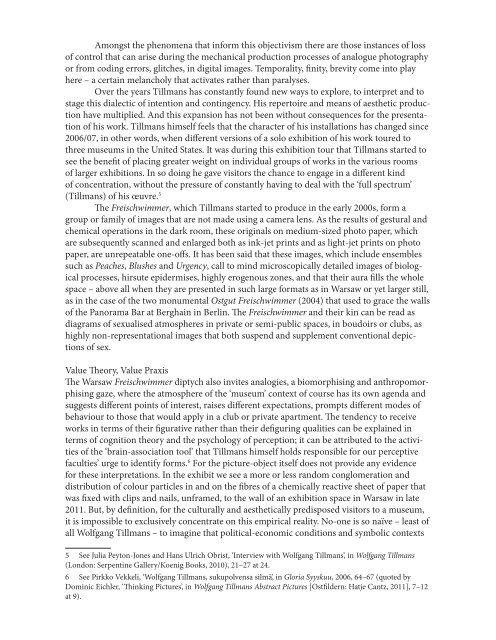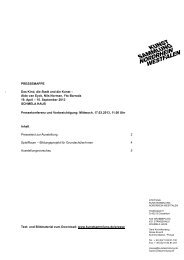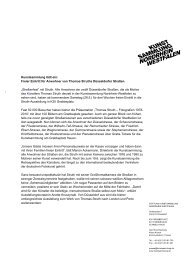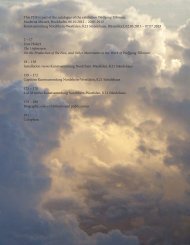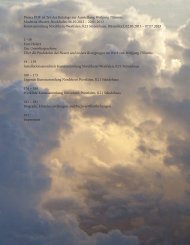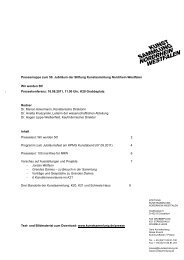Download online catalog (pdf)
Download online catalog (pdf)
Download online catalog (pdf)
You also want an ePaper? Increase the reach of your titles
YUMPU automatically turns print PDFs into web optimized ePapers that Google loves.
Amongst the phenomena that inform this objectivism there are those instances of loss<br />
of control that can arise during the mechanical production processes of analogue photography<br />
or from coding errors, glitches, in digital images. Temporality, finity, brevity come into play<br />
here – a certain melancholy that activates rather than paralyses.<br />
Over the years Tillmans has constantly found new ways to explore, to interpret and to<br />
stage this dialectic of intention and contingency. His repertoire and means of aesthetic production<br />
have multiplied. And this expansion has not been without consequences for the presentation<br />
of his work. Tillmans himself feels that the character of his installations has changed since<br />
2006/07, in other words, when different versions of a solo exhibition of his work toured to<br />
three museums in the United States. It was during this exhibition tour that Tillmans started to<br />
see the benefit of placing greater weight on individual groups of works in the various rooms<br />
of larger exhibitions. In so doing he gave visitors the chance to engage in a different kind<br />
of concentration, without the pressure of constantly having to deal with the ‘full spectrum’<br />
(Tillmans) of his œuvre. 5<br />
The Freischwimmer, which Tillmans started to produce in the early 2000s, form a<br />
group or family of images that are not made using a camera lens. As the results of gestural and<br />
chemical operations in the dark room, these originals on medium-sized photo paper, which<br />
are subsequently scanned and enlarged both as ink-jet prints and as light-jet prints on photo<br />
paper, are unrepeatable one-offs. It has been said that these images, which include ensembles<br />
such as Peaches, Blushes and Urgency, call to mind microscopically detailed images of biological<br />
processes, hirsute epidermises, highly erogenous zones, and that their aura fills the whole<br />
space – above all when they are presented in such large formats as in Warsaw or yet larger still,<br />
as in the case of the two monumental Ostgut Freischwimmer (2004) that used to grace the walls<br />
of the Panorama Bar at Berghain in Berlin. The Freischwimmer and their kin can be read as<br />
diagrams of sexualised atmospheres in private or semi-public spaces, in boudoirs or clubs, as<br />
highly non-representational images that both suspend and supplement conventional depictions<br />
of sex.<br />
Value Theory, Value Praxis<br />
The Warsaw Freischwimmer diptych also invites analogies, a biomorphising and anthropomorphising<br />
gaze, where the atmosphere of the ‘museum’ context of course has its own agenda and<br />
suggests different points of interest, raises different expectations, prompts different modes of<br />
behaviour to those that would apply in a club or private apartment. The tendency to receive<br />
works in terms of their figurative rather than their defiguring qualities can be explained in<br />
terms of cognition theory and the psychology of perception; it can be attributed to the activities<br />
of the ‘brain-association tool’ that Tillmans himself holds responsible for our perceptive<br />
faculties’ urge to identify forms. 6 For the picture-object itself does not provide any evidence<br />
for these interpretations. In the exhibit we see a more or less random conglomeration and<br />
distribution of colour particles in and on the fibres of a chemically reactive sheet of paper that<br />
was fixed with clips and nails, unframed, to the wall of an exhibition space in Warsaw in late<br />
2011. But, by definition, for the culturally and aesthetically predisposed visitors to a museum,<br />
it is impossible to exclusively concentrate on this empirical reality. No-one is so naïve – least of<br />
all Wolfgang Tillmans – to imagine that political-economic conditions and symbolic contexts<br />
5 See Julia Peyton-Jones and Hans Ulrich Obrist, ‘Interview with Wolfgang Tillmans’, in Wolfgang Tillmans<br />
(London: Serpentine Gallery/Koenig Books, 2010), 21–27 at 24.<br />
6 See Pirkko Vekkeli, ‘Wolfgang Tillmans, sukupolvensa silmä’, in Gloria Syyskuu, 2006, 64–67 (quoted by<br />
Dominic Eichler, ‘Thinking Pictures’, in Wolfgang Tillmans Abstract Pictures [Ostfildern: Hatje Cantz, 2011], 7–12<br />
at 9).


